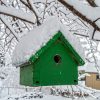How to Get Your Lawn Looking Green This Spring

Your lawn has been dormant all winter, but now that spring has arrived, you are eager to see healthy, lush grass throughout your yard. Unfortunately, any lingering issues from the last growing season may still be present or may have even worsened. Furthermore, a long, harsh winter season can take a nasty toll on your lawn. The efforts taken now to improve the health and appearance of your lawn can be enjoyed throughout the growing season. Use these tips to get your lawn moving along on healthy footing this spring.
Rake Winter Remnants
When snow and ice melt away, you may be disheartened to see a lawn that appears to be barely alive. One of the reasons why lawns struggle in the spring is because of excessive thatch. Thatch is an accumulation of organic matter, such as crushed up leaves and dead grass, that resides on the soil just below the grass blades. A thin layer of thatch can help your soil to remain hydrated and may promote a healthy lawn. If thatch is more than a half-inch thick, however, it should be raked away. This allows moisture and fresh air to reach the soil more easily.
Assess the Need for Aeration
Soil can compact firmly over time, so spring is the natural time to assess the need for aeration. When soil is too firm, water and air cannot easily reach the roots. As a result, your grass may struggle to survive. Aeration is an effective way to loosen the soil, and it may have a positive effect on the health of your grass. Compact soil may be the result of heavy foot traffic, excessive snow and ice over the winter, drought conditions or even heavy rain.
Kill the Weeds
It can be frustrating to see weeds thriving in your yard while your grass looks sickly. Weeds can easily take over a yard, so periodic weed treatment may be required. If weed growth is pervasive, the application of a broadleaf weed killer may stop weed growth without damaging the grass. Organic weed killer products are also available and effective. After the weeds are gone, your lawn may look patchy. Grass plugs or seed may then be necessary.
Choose the Right Fertilizer
Both natural and organic fertilizers can have wonderful effects on lawn health. However, soil conditions vary by location and even based on the types of vegetation in your yard. You may test your soil to determine its needs, or you can request soil testing and analysis from a professional landscaping company. While fertilization in the spring can be helpful, avoid over-fertilization or applying products that are not well-suited for your soil’s needs.
Hydrate Periodically
Your lawn needs a steady supply of water, so using an automatic sprinkler system that does not have a built-in weather sensor may produce undesirable results. The best type of water for your lawn is natural rainwater. Investing in a rainwater collection system is a smart way to capture the healthy water that your vegetation needs. Water for longer periods of time less frequently to promote the deep growth of grass roots.
Know When to Mow
Your lawnmower blades should be sharpened each spring. Dull blades can cause grass blades to splinter and may stress your lawn. Mowing too frequently can also cause unnecessary stress to your lawn. Allow the grass to grow a few inches between each mowing session. Remember not to cut the blades too short as this may damage the grass. Furthermore, grass should only be mowed when it is dry. Mowing damp grass can result in diseased areas throughout the yard.
The steps that you take this spring to rejuvenate your lawn can establish a gorgeous yard that you can be proud of. Your yard will require regular care and attention throughout the summer and beyond to ensure ongoing health. If you struggle with lawn care and maintenance or if your lawn is in very poor condition, consider consulting with a lawn care expert for one-time or ongoing assistance.

















